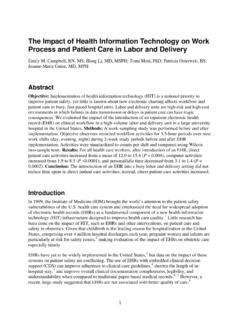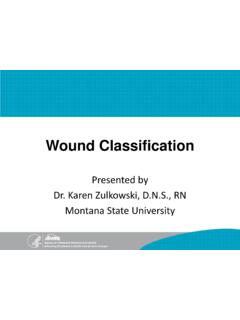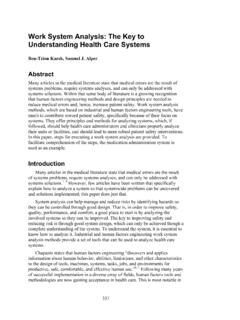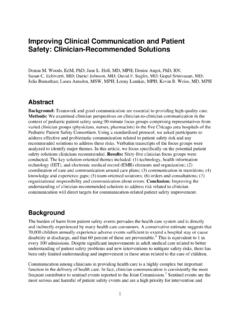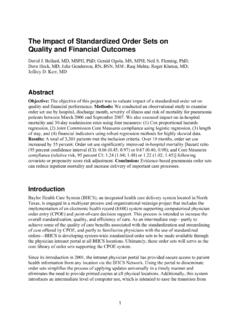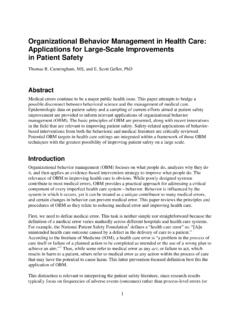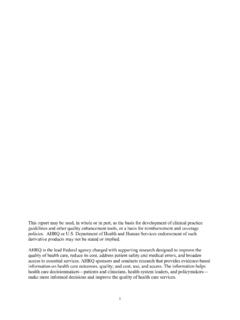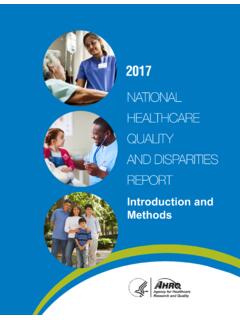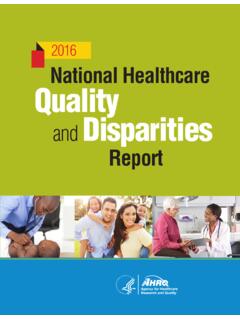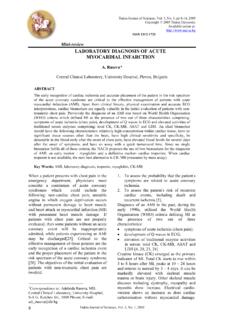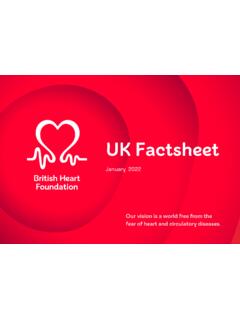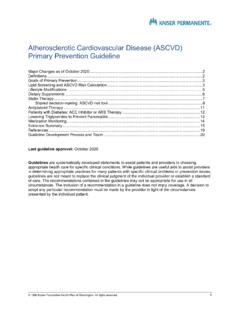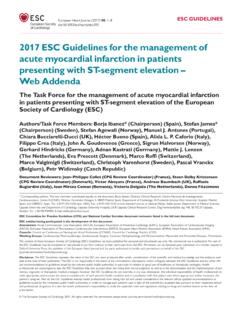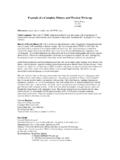Transcription of Secondary Prevention of Cardiovascular Disease (CVD)
1 Secondary Prevention of Cardiovascular Disease (CVD) 1 Secondary Prevention of Cardiovascular Disease (CVD) 2 Welcome by Michael Pignone, MD, MPH Hi. My name is Dr. Michael Pignone. I m a general internist and faculty member of the University of North Carolina Chapel Hill. In this Webinar I ll provide a discussion and update on Secondary Prevention of Cardiovascular Disease , also known as CVD. This presentation is one in the series of Webinars developed by our evidence team at the University of North Carolina. 3 Objectives Our objectives today in this Webinar will be: Number one, to review specific issues in medical therapy for patients with a history of CVD. This will include lipid-lowering therapy, antiplatelet agents, and blood pressure control; and, secondly, to review specific life-style interventions for patients with a history of CVD. This will include cardiac rehabilitation or exercise and dietary changes. 4 Mrs. Jones Let s start with a typical case. Mrs. Jones is a 59-year-old woman with a myocardial infarction four months ago.
2 She received a drug-alluding stent to her LAD artery, and her injection fraction at that time was normal. She s in your clinic today for follow up. Her medications include Clopidogrel 75 mg daily, Lisinopril 20 mg daily, Metoprolol 25 mg twice a day, and Pravastatin 40 mg daily, as well as aspirin 81 mg daily. Her blood pressure is 122/68 mmHg. Her heart rate is 68 BPM, and her total cholesterol is 215 mg per deciliter. Her triglycerides are 200 mg per deciliter. Her HGL cholesterol 40 mg per deciliter, and her LDL cholesterol 135 mg per deciliter. Her fasting blood glucose is 112 mg per deciliter. 5 Question Based on that information, what change, if any, would you make to her medication regimen? Would you add Eplerenone 25 mg daily, add Niaspan 500 mg daily with a titration to 2K mg as tolerated, discontinue Pravastatin and add Atorvastatin 80 mg daily, increase her aspirin dose to 325 mg daily, or make no change? 6 Who should receive Secondary Prevention ? Thi s is not an easy question.
3 But, fortunately, there s a good bit of guidance available to help us answer this question of Mrs. Jones, and for other patients like her in our practices. To start with, before we examine recommendations for Secondary Prevention , let s review who should receive Secondary Prevention and why this topic is important. The recommendations in this presentation on Secondary Prevention are directed to patients with a history of clinically significant atherosclerotic Cardiovascular Disease including a history of myocardial infarction, a history of angina, a history of prior revascularization either stenting or bypass surgery, a history of stroke or transient ischemic attack or TIA, and a history of symptomatic peripheral vascular Disease . 7 What are the goals of Secondary Prevention ? We will not cover the management of patients with acute coronary syndromes in this presentation, nor will we provide recommendations for patients with symptomatic heart failure. 8 What are the goals of Secondary Prevention ?
4 So, what are the goals of Secondary Prevention ? Number one, to prevent recurrent events like heart attacks or strokes; secondly, to prevent death; third, to improve symptoms; and, fourth, to improve quality of life. 9 Topics The main interventions we ll cover today include: lipid-lowering therapy, anti-platelet therapy, blood pressure control, Cardiovascular rehabilitation, and dietary modification. Smoking cessation is very important in Secondary Prevention , but it will be addressed in a second Webinar. 10 Lipid Lowering Therapy First, let s look at the use of lipid-lowering therapy in Secondary Statins are Effective in Secondary Prevention Statins are effective in Secondary Prevention . Evidence from multiple randomized trials show that statins reduced the risk of CVD events in patients with a history of Cardiovascular Disease . They reduce all-cause mortality by 19%, CHD mortality by 27%, myocardial infarction by 27%, and strokes by 16%. High-dose statins, when compared with moderate-dose statins, further reduce the combination of nonfatal myocardial infarction and CHD death by 10% and stroke by 14%.
5 12 Statin Prescribing in Secondary Prevention So, here s a table of statin-prescribing and Secondary Prevention . For patients under age 75, we recommend that you initiate high-intensity statin for Secondary Prevention such as Atorvastatin 40 mg daily. For patients over age 75, or in whom high-intensity statin is not well-tolerated, we recommend that you initiate moderate-intensity statin using any of the recommended agents on the right side of the table. 13 Recommendation We you not routinely recommend that you add other lipid-lowering therapy to statins, because it provides little additional benefit with higher costs and greater potential for adverse effects. For those patients at very high risk who cannot tolerate statins, you can consider using alternative agents. One new, but unproven, option is the use of PCSK9 inhibitors. 14 PCSK9 Inhibitors PCSK9 inhibitors are a new class of injectable drugs that were recently FDA approved. They lower LDL cholesterol level by 50% or more.
6 However, their safety and efficacy for CVD event reduction are still being evaluated. They may be a reasonable option for patients at high risk who are not able to tolerate statins. Their biggest limitation is cost which is estimated at over $12,000 per year. 15 Antiplatelet Therapy Now, let s review the use of anti-platelet agents for Secondary Prevention . 16 Aspirin in Secondary Prevention Let s start by looking at aspirin. Aspirin works by selectively and irreversibly inhibiting cyclooxygenase and, thus, reducing platelet aggregation. Daily 81 mg aspirin effectively reduces recurrent CVD events by 20 percent or more. The main risk of aspirin, and other anti-platelet agents is bleeding, mostly gastrointestinal. The risk of GI bleeding varies with age, and is greater than 1% per year in the elderly. Patients may also experience annoying bruising and dyspepsia, or upset stomach. 17 P2Y12 Inhibitors in Secondary Prevention in Patients with Prior Stents Now, let s examine the other main class of anti-platelet drugs, the P2Y12 inhibitors such as Clopidogrel.
7 First, we ll review the use of these drugs in patients who have stents. These patients, along with their high general risk of Secondary Prevention patients, are at particularly high risk for stent-related thrombosis. For patients with stents, P2Y12 inhibitors are used, along with aspirin 81 mg once daily. They reduce platelet activation and aggregation by different mechanism than aspirin. There are three P2Y12 inhibitors available. Clopidogrel is available generically and is the preferred agent for most patients. The prescribed P2Y12 inhibitor should be taken for at least one month post the implantation of a bare-metal stent or for at least one year post the implantation of a drug eluting stent. P2Y12 inhibitors reduce stent-related thrombosis and also reduce the risk of recurrent events. However, the addition of these drugs also increases the risk of bleeding. If non-life-threatening serious bleeding occurs, consult with the patient s cardiologist about whether to withdraw therapy.
8 Similarly, providers should query for medication cost-related nonadherence and treat it by prescribing generics or seeking medication assistance program. 18 P2Y12 Inhibitors in Secondary Prevention in Patients without Prior Stents Now, let s look at the use of P2Y12 inhibitors in patients without prior stents. Compared to aspirin, the use of a P2Y12 inhibitor showed minimal improvement in terms of benefit with much-higher costs. Thus, P2Y12 inhibitor monotherapy should only be used in patients who cannot tolerate aspirin. Adding P2Y12 inhibitors to aspirin had minimal incremental value in terms of benefit with much-higher costs and increased risk of bleeding. So, we don t routinely recommend that. 19 Anticoagulation and Antiplatelet Agents Some Secondary Prevention patients may be taking an anticoagulation medication like warfarin, or one of the novel anticoagulants, for another condition such as atrial fibrillation or venous thrombembolic Disease . In patients receiving anticoagulation, we do not recommend that you add an antiplatelet agent due to very high bleeding risks, except in patients with prior coronary- artery stents.
9 20 Blood Pressure Control Now, let s turn to blood pressure control. 21 Choice of Antihypertensive Drugs Blood-pressure controlled patients with prior CVD events is only slightly different than for primary Prevention . Patients with elevated blood pressure, prior history of myocardial infarction, and normal systolic function, should consider use of Beta blocker like Metoprolol, especially within three years of the event. Angiotensin blocking drugs have also shown effectiveness for Secondary Prevention . For those with a reduced ejection fraction, Beta blockers and angiotensin blocking drugs are both generally indicated. Treatment should aim to reduce blood pressure at least under 140/90 mg of mercury. These agents may also improve Cardiovascular symptoms. 22 Lifestyle Modifications Now, let s examine the role of life-style modifications in Secondary Prevention . We ll discuss two main areas: cardiac rehabilitation and dietary modification. 23 Cardiovascular Rehabilitation Cardiac rehabilitation uses a multidisciplinary approach to reduce the impact of Cardiovascular Disease and prevent future events.
10 It usually involves structured exercise, as well as coping skills and medication adherence support. Rigorous studies suggest that cardiac rehabilitation can reduce mortality by up to 25% compared to medical therapy alone. Cardiac rehabilitation is indicated for patients with coronary heart Disease such as angina, myocardial infarction, or coronary revascularization. Patients with a prior stroke benefit from stroke-specific rehabilitation. 24 Cardiovascular Rehabilitation This slide shows a map of cardiac rehabilitation facilities throughout North Carolina. Visit: to locate a facility near you. 25 Dietary Change Perhaps the best evidence for dietary intervention for patients with known Cardiovascular Disease comes from the Lyon Heart Study. In this trial patients were randomized to Mediterranean-style diet compared with the more-traditional Western-European diet. The Mediterranean diet group showed reduced all-cause in Cardiovascular mortality. Based on this trial, we recommend a diet that is high in fruits, vegetables, beans, nuts, seeds, and healthy oils like olive oil.

